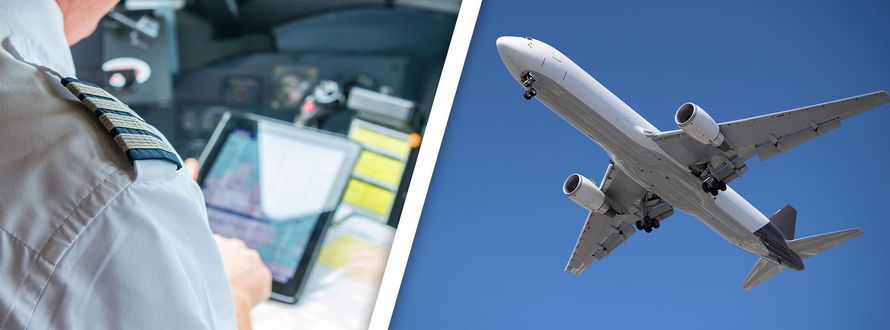An Electronic Flight Bag (EFB) is a specialized electronic device or software application used in aviation to assist flight crews in various aspects of their job. It has largely replaced traditional paper-based materials and charts, making it a valuable tool for modern aircraft operations. EFBs can take the form of dedicated hardware devices or software applications on tablets or other portable devices.
Here are some of the key functions and uses of EFBs in planes:
- Navigation and Charts:
EFBs provide digital maps, charts, and navigation tools that assist pilots in route planning, navigation during the flight, and approach and departure procedures. This includes displaying airport diagrams, en-route charts, and instrument approach procedures. - Performance Calculations:
EFBs help calculate and display critical performance data, such as takeoff and landing performance, fuel consumption, and weight and balance calculations. This information is essential for flight planning and safety. - Weather Information:
EFBs can access real-time weather data and forecasts, helping flight crews make informed decisions about route adjustments, turbulence avoidance, and alternate airport selections. - Documentation, Manuals and Checklists:
EFBs often include digital versions of aircraft manuals, operating procedures, checklists, and other reference materials. This makes it easy for pilots to access the information they need quickly. They also allow for the management and execution of various checklists, ensuring that crews follow the correct procedures during all phases of flight. - Communication and Flight Logs:
EFBs can be used for electronic communication with air traffic control and airline operations, enhancing situational awareness and improving coordination during the flight. EFBs can also automatically record flight data, which is useful for tracking flight hours, fuel consumption, and maintenance needs. - Airport Information:
They provide details about airports, including terminal layouts, services available, and information on Fixed-Base Operators (FBOs). - Custom Applications:
Some EFB systems allow airlines to develop custom applications for specific operational needs, enhancing efficiency and safety.
However, this reliance on EFBs also brings new security and safety challenges, as the data stored on these devices contains sensitive information about the aircraft and flight. To ensure safe and reliable flight operations, the EFB system must be protected from unauthorized access, tampering, and failures.
Safety and Security first with PikeOS
In order to address these challenges, a Real-Time Operating System (RTOS) can play a crucial role in the implementation of Electronic Flight Bags (EFBs). The secure partitioning and real-time capabilities of PikeOS provide the necessary embedded security and safety requirements for the EFB system to operate independently and securely from other systems on the aircraft. This separation ensures a high level of security and privacy for the flight data, as well as real-time performance and reliability. In addition, the Common Criteria certification EAL 5+ of PikeOS provides the necessary assurance for use in avionics systems, meeting the stringent security requirements for airborne use.
One of the key benefits of using PikeOS for EFBs is its ability to create isolated, secure environments for different applications and data. This allows the EFB system to operate independently and securely from other systems on the aircraft, such as the Flight Management System (FMS) or the avionics bus. This separation not only provides a high level of security and privacy for the flight data, but also helps to reduce the risk of interference or failures from other systems.
In addition to secure partitioning, PikeOS also provides real-time performance ensuring that the flight data and procedures displayed on the EFB are up-to-date and accurate, and that the system is able to respond to inputs and commands from the pilot in a timely manner. This is critical for ensuring safe and efficient flight operations, and helps to prevent errors or delays caused by slow or unreliable systems.
PikeOS' certification to Common Criteria EAL 5+ provides the necessary assurance for use in avionics systems, and meets the stringent security requirements for airborne use. The certification process includes rigorous testing and evaluation of the security and reliability of the system, ensuring that the EFB system is able to operate safely and securely even in the face of threats or attacks.
Conclusion
Electronic Flight Bags (EFBs) are a crucial tool that helps streamline flight operations, reduce the need for paper documents, improve situational awareness, and enhance safety. They have become standard equipment in modern cockpits, contributing to the efficiency and effectiveness of flight crews while reducing the environmental impact of aviation by minimizing paper usage.
The use of an RTOS like PikeOS provides the necessary embedded security and safety requirements for the implementation of Electronic Flight Bags (EFBs) in aviation. The secure partitioning and real-time capabilities of PikeOS ensure a high level of security and privacy for the flight data, as well as real-time performance and reliability. The Common Criteria certification EAL 5+ of PikeOS also provides the necessary assurance for use in avionics systems, meeting the stringent security requirements for airborne use. With its ability to create isolated, secure environments for different applications and data, PikeOS is an ideal solution for the implementation of EFBs in modern aviation.
More information at www.sysgo.com/pikeos

